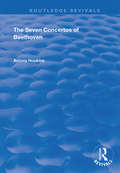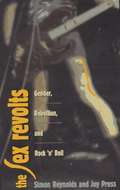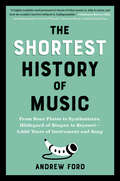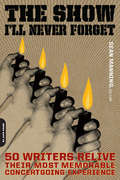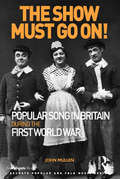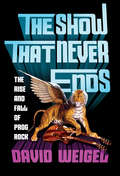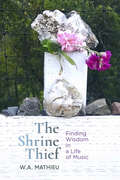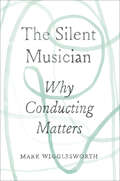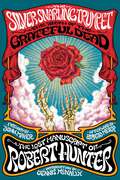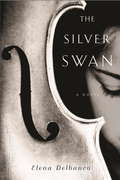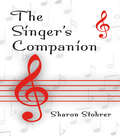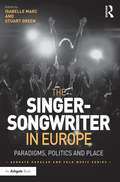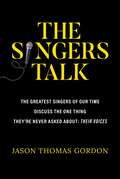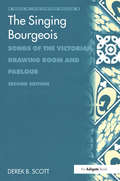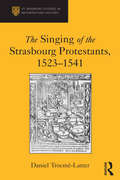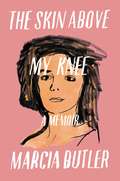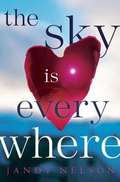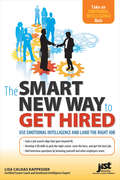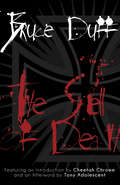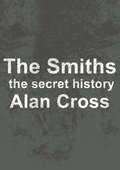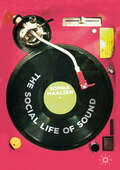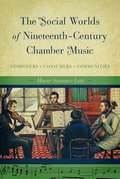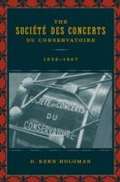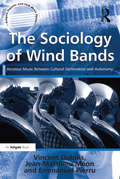- Table View
- List View
The Seven Concertos of Beethoven (Routledge Revivals)
by Antony HopkinsFirst published in 1996, this volume counters the attitude of paying more attention to the performer than to the piece. Too often, Anthony Hopkins argues, music is simply regarded as a pleasant background noise to accompany our other activities, whereas Beethoven offers much more than that. Hopkins aim to promote hearing, rather than listening. He examines Beethoven’s piano concertos numbers 1 through 5, along with the violin concerto in D Major, Op. 61, and the Triple Concerto, Op. 56.
The Sex Pistols: The Secret History (The\secret History Of Rock Ser.)
by Alan CrossAlan Cross is the preeminent chronicler of popular music.Here he provides a history of punk-rock revolutionaries The Sex Pistols.This look at the band—"Delivering Anarchy to the UK"—is adapted from the audiobook of the same name.
The Sex Revolts: Gender, Rebellion, and Rock'n'roll
by Simon ReynoldsThe Sex Revolts captures the paradox at rock's dark heart--the music is often most thrilling when it is most misogynistic and macho. And, looking at music made by female artists, the authors ask: must it always be this way? Provocative and passionately argued, the book walks the edgy line between a rock fan's excitement and a critic's awareness of the music's murky undercurrents.
The Shortest History of Music: From Bone Flutes to Synthesizers, Hildegard of Bingen to Beyoncé - 5,000 Years of Instrument and Song (The Shortest History Series)
by Andrew FordFrom prehistoric songwriting to digital recording, discover the history of the world’s favorite art form No other art is as popular—or pervasive—as music. With just a few clicks, anyone can cue up (and critique) Chopin or Cher, The Bangles or The Beatles—even the brand-new Beyoncé. But things weren’t always this way. In this brisk, breakneck history under 300 pages, award-winning composer, author, and broadcaster Andrew Ford replays the dramatic evolution of music, from early oral songs to the first orchestras (and their wealthy patrons) and from the emergence of recording technology to the multibillion-dollar industry we know today. The Shortest History of Music explores the immense influence of religion, politics, and the economy on world music, what led humans to make music in the first place, and why—in every era—we are irresistibly drawn to listen to it. The Shortest History books deliver thousands of years of history in one riveting, fast-paced read.
The Show I'll Never Forget: 50 Writers Relive Their Most Memorable Concertgoing Experience
by Sean ManningIn The Show I’ll Never Forget, writer Sean Manning has gathered an amazing array of unforgettable concert memories from a veritable A-list of acclaimed novelists, poets, biographers, cultural critics, and songwriters. Their candid, first-person recollections reveal as much about the writers’ lives at the time as they do about the venues where the shows occurred or the artists onstage. Ishmael Reed on Miles Davis Luc Sante on Public Image Ltd. Heidi Julavits on Rush Daniel Handler and Andrew Sean Greer on Metric Diana Ossana on Led Zeppelin Maggie Estep on Einsturzende Neubauten Dani Shapiro on Bruce Springsteen Gary Giddins on Titans of the Tenor! Nick Flynn on Mink DeVille Susan Straight on The Funk Festival Rick Moody on the The Lounge Lizards Jennifer Egan on Patti Smith Harvey Pekar on Joe Maneri Thurston Moore on Glen Branca, Rudolph Grey, and Wharton Tiers Chuck Klosterman on Prince Sigrid Nunez on Woodstock Jerry Stahl on David Bowie Charles R. Cross on Nirvana Marc Nesbitt on The Beastie Boys And many more . . . No matter where your musical taste falls, these often funny, occasionally sad, always thought-provoking essays-all written especially for The Show I’ll Never Forget-are sure to connect with anyone who loves, or has ever loved, live music.
The Show Must Go On! Popular Song in Britain During the First World War: Popular Song In Britain During The First World War (Ashgate Popular and Folk Music Series)
by John MullenUsing a collection of over one thousand popular songs from the war years, as well as around 150 soldiers’ songs, John Mullen provides a fascinating insight into the world of popular entertainment during the First World War. Mullen considers the position of songs of this time within the history of popular music, and the needs, tastes and experiences of working-class audiences who loved this music. To do this, he dispels some of the nostalgic, rose-tinted myths about music hall. At a time when recording companies and record sales were marginal, the book shows the centrality of the live show and of the sale of sheet music to the economy of the entertainment industry. Mullen assesses the popularity and significance of the different genres of musical entertainment which were common in the war years and the previous decades, including music hall, revue, pantomime, musical comedy, blackface minstrelsy, army entertainment and amateur entertainment in prisoner of war camps. He also considers non-commercial songs, such as hymns, folk songs and soldiers’ songs and weaves them into a subtle and nuanced approach to the nature of popular song, the ways in which audiences related to the music and the effects of the competing pressures of commerce, propaganda, patriotism, social attitudes and the progress of the war.
The Show That Never Ends: The Rise And Fall Of Prog Rock
by David WeigelThe wildly entertaining story of progressive rock, the music that ruled the 1970s charts—and has divided listeners ever since. The Show That Never Ends is the definitive story of the extraordinary rise and fall of progressive (“prog”) rock. Epitomized by such classic, chart-topping bands as Yes, Genesis, Pink Floyd, Jethro Tull, and Emerson Lake & Palmer, along with such successors as Rush, Marillion, Asia, Styx, and Porcupine Tree, prog sold hundreds of millions of records. It brought into the mainstream concept albums, spaced-out cover art, crazy time signatures, multitrack recording, and stagecraft so bombastic it was spoofed in the classic movie This Is Spinal Tap. With a vast knowledge of what Rolling Stone has called “the deliciously decadent genre that the punks failed to kill,” access to key people who made the music, and the passion of a true enthusiast, Washington Post national reporter David Weigel tells the story of prog in all its pomp, creativity, and excess. Weigel explains exactly what was “progressive” about prog rock and how its complexity and experimentalism arose from such precursors as the Beach Boys’ Pet Sounds and the Beatles’ Sgt. Pepper. He traces prog’s popularity from the massive success of Procol Harum’s “Whiter Shade of Pale” and the Moody Blues’ “Nights in White Satin” in 1967. He reveals how prog’s best-selling, epochal albums were made, including The Dark Side of the Moon, Thick as a Brick, and Tubular Bells. And he explores the rise of new instruments into the prog mix, such as the synthesizer, flute, mellotron, and—famously—the double-neck guitar. The Show That Never Ends is filled with the candid reminiscences of prog’s celebrated musicians. It also features memorable portraits of the vital contributions of producers, empresarios, and technicians such as Richard Branson, Brian Eno, Ahmet Ertegun, and Bob Moog. Ultimately, Weigel defends prog from the enormous derision it has received for a generation, and he reveals the new critical respect and popularity it has achieved in its contemporary resurgence.
The Shrine Thief
by W. A. MathieuA renowned musician in his 85th year explores the nature of wisdom, how we learn to recognize it, and how we pass it forward.In this entrancing memoir, timeless questions about music and life are explored by a master musician in his 85th year. The stern father who built an empire of words; the solipsistic uncle whose hypnotic voice calmed millions: these are just early glimpses of Mathieu's memory. Soon he is crimped into an overhead baggage rack in Stan Kenton's tour bus as scenes of scotch-soaked melancholy play out below; he is sharing late-night quarts of ice cream with Duke Ellington in his hotel room; he is co-inventing improvisational theater at Chicago's Second City with Alan Arkin and Mike Nichols; he is receiving the title of Sufi sheikh from an heir of Inayat Khan; and he is gleaning wisdom from a woman bundling firewood in Bali.In prose at once wry and lyrical, Mathieu carries the reader through the adventures and misadventures of a scintillating and deeply examined life.
The Silent Musician: Why Conducting Matters
by Mark WigglesworthThe conductor—tuxedoed, imposingly poised above an orchestra, baton waving dramatically—is a familiar figure even for those who never set foot in an orchestral hall. As a veritable icon for classical music, the conductor has also been subjected to some ungenerous caricatures, presented variously as unhinged gesticulator, indulged megalomaniac, or even outright impostor. Consider, for example: Bugs Bunny as Leopold Stokowski, dramatically smashing his baton and then breaking into erratic poses with a forbidding intensity in his eyes, or Mickey Mouse in Fantasia, unwittingly conjuring dangerous magic with carefree gestures he doesn’t understand. As these clichés betray, there is an aura of mystery around what a conductor actually does, often coupled with disbelief that he or she really makes a difference to the performance we hear. The Silent Musician deepens our understanding of what conductors do and why they matter. Neither an instruction manual for conductors, nor a history of conducting, the book instead explores the role of the conductor in noiselessly shaping the music that we hear. Writing in a clever, insightful, and often evocative style, world-renowned conductor Mark Wigglesworth deftly explores the philosophical underpinnings of conducting—from the conductor’s relationship with musicians and the music, to the public and personal responsibilities conductors face—and examines the subtler components of their silent art, which include precision, charisma, diplomacy, and passion. Ultimately, Wigglesworth shows how conductors—by simultaneously keeping time and allowing time to expand—manage to shape ensemble music into an immersive, transformative experience, without ever making a sound.
The Silver Snarling Trumpet: The Birth of the Grateful Dead—The Lost Manuscript of Robert Hunter
by Robert HunterDiscovered at last, the legendary lost manuscript of Grateful Dead co-founder and primary lyricist Robert Hunter, written in the early 1960s—a wry, richly observed, and enlightening remembrance of &“the scene&” in Palo Alto that gave rise to an incredible partnership of Hunter and Jerry Garcia, and then to the Grateful Dead itself—with a Foreword by John Mayer, an Introduction by Dennis McNally, and an Afterword by Brigid Meier. &“Strange to think back on those days when it was perfectly natural that we all slept on the floor in one small room.... These were the days before practical considerations, matters of &‘importance,&’ began to eat our minds. We were all poets and philosophers then, until we began to wonder why we had so few concrete worries and went out to look for some.&” So wrote Robert Hunter in The Silver Snarling Trumpet, both a novelistic singular work of art and the missing piece of the Grateful Dead origin story. In these pages, readers are privy to the early days of Hunter, Garcia, and their cohorts, who sit at coffee shops passing around a single cup of bottomless coffee because they lacked the funds for more than one. Follow these truth-seeking souls into the stacks at Kepler&’s Books, renting instruments at Swain&’s House of Music, and through the countryside on mind-expanding road trips. Witness impromptu jams, inspired intellectual pranks, and a dialogue that is, by turns, amusing and brilliant and outrageous. Hunter shares his impressions of his first gig with Garcia for a college audience, along with descriptions of his most intense dreams and psychedelic explorations. All of it, enlivened by Hunter&’s visionary spirit and profound ideas about creativity and collaboration. The lost manuscript is augmented with a Foreword by John Mayer, an Introduction by Dennis McNally, and an Afterword by Brigid Meier, who was part of their scene in the San Francisco Bay Area that served as a bridge from the beatniks to the hippies. Also included is Hunter&’s own 1982 assessment of his work—about how he shared it with close confidants but then decided to leave it unpublished. Five years after Hunter&’s death, the text has been found, so readers and fans of Hunter&’s indelible poetry and song can explore the origin of his genius and his craft.
The Silver Swan
by Elena DelbancoA debut novel about a daughter grappling with the legacy of her famous and imposing cellist father, the secrets he has hidden from her, and the fate of his great Stradivarius cello.Alexander Feldmann is a revered and sought-after performer whose prodigious talent, striking good looks and worldly charm prove irresistible to all who hear and encounter him. After years of searching, he acquires a glorious cello, the Silver Swan, a rare Stradivarius masterpiece long lost to the world of music. Mariana is Alexander's only child and the maestro has large ambitions for her. By the age of nineteen she emerges as a star cellist in her own right, and is seen as the inheritor of her father's genius. There are whispers that her career might well outpace his. Mariana believes the Silver Swan will one day be hers, until a stunning secret from her father's past entwines her fate and that of the Silver Swan in ways she could never have imagined.
The Singer's Companion
by Sharon L. Stohrer"The Singer’s Companion" provides both beginning and advanced students of singing with a basic, reliable, and readable introduction to the many issues focusing on training and maintaining a healthy voice. It covers all the fundamental issues faced by vocalists in all styles of music, including how to find a good teacher, work with a score, audition, and perform. Stohrer has written an essential text for students of singing, offering up-to-date, accurate, and accessible information that will be invaluable to singers and their teachers.
The Singer-Songwriter in Europe: Paradigms, Politics and Place (Ashgate Popular and Folk Music Series)
by Stuart Green Isabelle MarcThe Singer-Songwriter in Europe is the first book to explore and compare the multifaceted discourses and practices of this figure within and across linguistic spaces in Europe and in dialogue with spaces beyond continental borders. The concept of the singer-songwriter is significant and much-debated for a variety of reasons. Many such musicians possess large and zealous followings, their output often esteemed politically and usually held up as the nearest popular music gets to high art, such facets often yielding sizeable economic benefits. Yet this figure, per se, has been the object of scant critical discussion, with individual practitioners celebrated for their isolated achievements instead. In response to this lack of critical knowledge, this volume identifies and interrogates the musical, linguistic, social and ideological elements that configure the singer-songwriter and its various equivalents in Europe, such as the French auteur-compositeur-interprète and the Italian cantautore, since the late 1940s. Particular attention is paid to the emergence of this figure in the post-war period, how and why its contours have changed over time and space subsequently, cross-cultural influences, and the transformative agency of this figure as regards party and identity politics in lyrics and music, often by means of individual case studies. The book's polycentric approach endeavours to redress the hitherto Anglophone bias in scholarship on the singer-songwriter in the English-speaking world, drawing on the knowledge of scholars from across Europe and from a variety of academic disciplines, including modern language studies, musicology, sociology, literary studies and history.
The Singers Talk: The Greatest Singers of Our Time Discuss the One Thing They're Never Asked About: Their Voices
by Jason Thomas GordonA groundbreaking collection of inspiring and instructive conversations about the beauty, brutality, discipline, and technique of being a successful singer.&“This is a captivating look at both the nitty-gritty preparation and emotional energy that &‘it takes [for artists] to stand up to that mic... reach down into their guts, and give everything they&’ve got for the sake of the song.&’ Its star power and up-close, revelatory detail will keep readers riveted from start to finish.&” —Publishers Weekly, starred review &“For all of the conversations we have about music, there is precious little talk about the art of communicating emotion and meaning via the human voice. The Singer's Talk remedies this by reaching out to a wide range of different singers, who speak insightfully about both the skill and the magic required to change minds and break hearts.&” —Steven Hyden, author of Twilight of the Gods and other books These revelatory, frequently funny, and deeply engrossing in-depth interviews provide fans and aspiring singers a backstage pass to the challenges every vocalist faces onstage and in the studio. Packed with never-before-heard stories, The Singers Talk reveals a truly intimate side to these iconic personalities while offering a master class on how the best in their field keep their vocal cords in shape and protect themselves on the road—along with countless other tricks, techniques, strategies, and philosophies to help vocalists at every level perfect the craft of singing. &“This is the most geeked out I&’ve ever talked about my voice!&” —Thom Yorke This historic roster of artists includes: Bryan Adams, Tony Bennett, Nick Cave, Chuck D, Roger Daltrey, Joe Elliott, Emmylou Harris, Brittany Howard, Chrissie Hynde, Norah Jones, Simon Le Bon, Geddy Lee, Willie Nelson, Stevie Nicks, Ozzy Osbourne, Steve Perry, Lionel Richie, LeAnn Rimes, Smokey Robinson, Robert Smith, Bruce Springsteen, Mavis Staples, Rod Stewart, Paul Stanley, Michael Stipe, Jeff Tweedy, Roger Waters, Dionne Warwick, Ann Wilson, Thom Yorke, and many more. Additionally, the book features conversations about legendary voices no longer with us, such as Butch Vig on Kurt Cobain, Clive Davis on Whitney Houston, Nile Rodgers on David Bowie, and Jimmy Iovine on Tom Petty. &“Singing is so much more than hitting the right note. It&’s about connecting with the audience, connecting with something divine to a certain degree. It&’s connecting to your most primitive and deepest intuition, and to your nature as a human on this planet.&” —Karen O. More than just an indispensable guide for singers of any level, The Singers Talk is an unforgettable read for music fans everywhere. All royalties from The Singers Talk will benefit the kids and families at St. Jude Children&’s Research Hospital through their Music Gives to St. Jude Kids campaign.
The Singing Bourgeois: Songs of the Victorian Drawing Room and Parlour (Music In Nineteenth-century Britain Ser.)
by Derek B. ScottFirst published in 1989, The Singing Bourgeois challenges the myth that the 'Victorian parlour song' was a clear-cut genre. Derek Scott reveals the huge diversity of musical forms and styles that influenced the songs performed in middle class homes during the nineteenth century, from the assimilation of Celtic and Afro-American culture by songwriters, to the emergence of forms of sacred song performed in the home. The popularity of these domestic songs opened up opportunities to women composers, and a chapter of the book is dedicated to the discussion of women songwriters and their work. The commercial success of bourgeois song through the sale of sheet music demonstrated how music might be incorporated into a system of capitalist enterprise. Scott examines the early amateur music market and its evolution into an increasingly professionalized activity towards the end of the century. This new updated edition features an additional chapter which provides a broad survey of music and class in London, drawing on sources that have appeared since the book's first publication. An overview of recent research is also given in a section of additional notes. The new bibliography of nineteenth-century British and American popular song is the most comprehensive of its kind and includes information on twentieth-century collections of songs, relevant periodicals, catalogues, dictionaries and indexes, as well as useful databases and internet sites. The book also features accompanying downloadable resources of songs from the period.
The Singing of the Strasbourg Protestants, 1523-1541 (St Andrews Studies in Reformation History)
by Daniel Trocmé-LatterMusic was, in some form or another, a pastime enjoyed by all in sixteenth-century society, and a fundamental part of their lives. It was both through the use of music and partly as a result of its existence that many religious changes occurred during the Reformation. This book explores the part played by music, especially group singing, in the unfolding of the Protestant reforms in Strasbourg. It considers both ecclesiastical and ’popular’ songs in the city, examining how both genres fitted into people’s lives during this time of strife, and how the provision and dissemination of music as a whole affected, and in turn was affected by, the new ecclesiastical arrangement. Whilst it would be naive to assume that the congregations were transformed from impious to pious overnight as the result of the introduction of German hymns, it is clear that there were real and concerted efforts on the part of reformers to get people to embrace the new faith, and writing hymns for them to sing was central to the process. Drawing upon a range of sources - including liturgical orders and hymnals, polemical songs, chronicles of the Reformation and text manuscripts - the book explores the methods by which new songs were introduced in Strasbourg churches, and suggests how congregations might have learnt them. In so doing it provides an account of the process by which reformers found music a place in the new Church, and used it to promote their wider reform agenda.
The Skin Above My Knee
by Marcia ButlerThe unflinching story of a professional oboist who finds order and beauty in music as her personal life threatens to destroy her.Music was everything for Marcia Butler. Growing up in an emotionally desolate home with an abusive father and a distant mother, she devoted herself to the discipline and rigor of the oboe, and quickly became a young prodigy on the rise in New York City's competitive music scene. But haunted by troubling childhood memories while balancing the challenges of a busy life as a working musician, Marcia succumbed to dangerous men, drugs and self-destruction. In her darkest moments, she asked the hardest question of all: Could music truly save her life?A memoir of startling honesty and subtle, profound beauty, The Skin Above My Knee is the story of a woman finding strength in her creative gifts and artistic destiny. Filled with vivid portraits of 1970's New York City, and fascinating insights into the intensity and precision necessary for a career in professional music, this is more than a narrative of a brilliant musician struggling to make it big in the big city. It is the story of a survivor.
The Sky Is Everywhere
by Jandy NelsonSeventeen-year-old Lennie Walker, bookworm and band geek, plays second clarinet and spends her time tucked safely and happily in the shadow of her fiery older sister Bailey. But when Bailey dies abruptly, Lennie is catapulted to center stage of her own life -- and, despite her nonexistent history with boys, suddenly finds herself struggling to balance two. Toby was Bailey's boyfriend; his grief mirrors Lennie's own. Joe is the new boy in town, a transplant from Paris whose nearly magical grin is matched only by his musical talent. For Lennie, they're the sun and the moon; one boy takes her out of her sorrow, the other comforts her in it. But just like their celestial counterparts, they can't collide without the whole wide world exploding. Just as much a celebration of love as it is a portrait of loss, Lennie's struggle to sort her own melody out of the noise around her is always honest, often hilarious, and ultimately unforgettable.
The Smart New Way to Get Hired
by Lisa KappesserProvides a quiz that helps job seekers assess their level of emotional intelligence. Practical exercises and examples teach them how to stand out in the job search, by using four areas of emotional intelligence: self awareness, self-management, social awareness, and social skills.
The Smell of Death
by Bruce Duff Cheetah Chrome Tony AdolescentMusician, producer, manager, rock journalist, indie label executive: Southern California native Bruce Duff has seen and been a part of more rock and roll fantasies come to life than the average guy with long hair and a penchant for living the dream. From playing with the legendary GG Allin, the Angry Samoans' Jeff Dahl, and the Dead Boys' Cheetah Chrome to running Triple X Records and writing for the most acclaimed publications in the genres, Duff remembers things past with The Smell of Death, his ode to the good times and his acceptance of the bad.
The Smiths: The Secret History (The\secret History Of Rock Ser.)
by Alan CrossAlan Cross is the preeminent chronicler of popular music.Here he provides a history of The Smiths, the definitive British indie band of the 1980s.This look at the band—"Those Charming Men"—is adapted from the audiobook of the same name.
The Social Life of Sound
by Sophia MaalsenThe Social Life of Sounds argues for the agency of sounds and music and the acceleration of their social lives in the Digital Age. Drawing upon research with composers, producers, record collectors, DJs and record labels, the book problematises the notion of artistic authorship as it is framed in Western systems of property. Acknowledging that ‘things’ – sounds, samples, and recorded music – and people are co-constituted and that personhood is distributed through things and their reuse, Maalsen makes a case for understanding sound as multibiographical and challenges the possessive individual that is the basis of artistic copyright.
The Social Worlds of Nineteenth-Century Chamber Music: Composers, Consumers, Communities
by Marie Sumner LottMarie Sumner Lott examines the music available to musical consumers in the nineteenth century, and what that music tells us about their tastes, priorities, and activities. Her social history of chamber music performance places the works of canonic composers such as Schubert, Brahms, and Dvorák in relation to lesser-known but influential peers. The book explores the dynamic relationships among the active agents involved in the creation of Romantic music and shows how each influenced the others' choices in a rich, collaborative environment. In addition to documenting the ways companies acquired and marketed sheet music, Sumner Lott reveals how the publication and performance of chamber music differed from that of ephemeral piano and song genres or more monumental orchestral and operatic works. Several distinct niche markets existed within the audience for chamber music, and composers created new musical works for their use and enjoyment. Insightful and groundbreaking, The Social Worlds of Nineteenth-Century Chamber Music revises prevailing views of middle-class influence on nineteenth-century musical style and presents new methods for interpreting the meanings of musical works for musicians both past and present.
The Societe des Concerts du Conservatoire, 1828-1967
by D. Kern HolomanThis is the story of one of the world's great philharmonic societies, told by a distinguished conductor and writer. Holoman chronicles the life of the Societe, from its day-to-day operations to its role in creating the canon of orchestral concert music in our culture. In English.
The Sociology of Wind Bands: Amateur Music Between Cultural Domination and Autonomy (Ashgate Popular and Folk Music Series)
by Vincent Dubois Jean-Matthieu Méon translated by BartDespite the musical and social roles they play in many parts of the world, wind bands have not attracted much interest from sociologists. The Sociology of Wind Bands seeks to fill this gap in research by providing a sociological account of this musical universe as it stands now. Based on a qualitative and quantitative survey conducted in northeastern France, the authors present a vivid description of the orchestras, the backgrounds and practices of their musicians, and the repertoires they play. Their multi-level analysis, ranging from the cultural field to the wind music subfield and to everyday life relationships within bands and local communities, sheds new light on the social organisation, meanings and functions of a type of music that is all too often taken for granted. Yet they go further than merely portraying a musical genre. As wind music is routinely neglected and socially defined in terms of its poor musical quality or even bad taste, the book addresses the thorny issue of the effects of cultural hierarchy and domination. It proposes an imaginative and balanced framework which, beyond the specific case of wind music, is an innovative contribution to the sociology of lowbrow culture.
